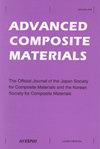热固性碳纤维布凝胶化过程中多尺度凝固的实验表征及其流动和应力模拟
IF 2.3
3区 材料科学
Q3 MATERIALS SCIENCE, COMPOSITES
引用次数: 0
摘要
摘要预浸料中存在单向排列纤维和未固化热固性树脂两种流动机制。这些机制是树脂从纤维间隙流出的渗透流动,以及树脂和纤维一起流动的剪切流动。根据我们之前的研究,我们假设渗透流动是由基体树脂的流变性控制的,而剪切流动是由预浸料的流变性控制的。基于这一假设,我们通过实验评估了凝胶过程中的“多尺度”固化(基体树脂和预浸料的固化)过程。通过观察损失角的发展来考察基体树脂的凝固过程,从而对固化过程进行了连续的描述。另一方面,通过分析预浸料的剪切储存模量与基体树脂的剪切储存模量之间的关系,表征预浸料的凝固过程。最后,我们考察了预浸料和基质树脂在凝胶化过程中固化过程的差异。关键词:热固性预流变特性凝胶相变过程建模公开声明作者未报告潜在的利益冲突。本工作由JSPS KAKENHI资助号JP17H03144/JP20H02028支持。本研究得到了JSPS KAKENHI 23H01604的部分支持。本研究得到了科学技术与创新委员会(CSTI)、跨部门战略创新促进计划(SIP)“结构材料革命性设计体系的材料集成”(资助机构:JST)的支持。本文章由计算机程序翻译,如有差异,请以英文原文为准。
Experimental characterization of multiscale solidification in thermoset CFRP during gelation for flow and stress modeling
AbstractTwo types of flow mechanisms consisting of unidirectionally arrayed fibers and uncured thermoset resin exist in prepreg materials. These mechanisms are percolation flow where resin flows out of the gaps between fibers, and shear flow where resin and fibers flow together. Based on our previous study, we assumed that percolation flow is controlled by the rheology of the matrix resin, whereas shear flow is controlled by the rheology of prepreg. Based on this assumption, we experimentally evaluated the ‘multiscale’ solidification (solidification of matrix resin and that of prepreg) process using dynamic mechanical analysis during gelation. The solidification of matrix resin was examined by observing the development of loss angle, which provides a continuous description of the solidification process. On the other hand, the solidification of prepreg was characterized by analyzing the relationship between the shear storage modulus of prepreg and that of the matrix resin. Finally, we examined the difference in the solidification process between prepreg and matrix resin during gelation.Keywords: Thermoset prepregrheological propertiesgelationphase transition;process modeling Disclosure statementNo potential conflict of interest was reported by the author(s).Additional informationFundingThis work was supported by JSPS KAKENHI Grant Number JP17H03144/JP20H02028. This research was partially supported by JSPS KAKENHI 23H01604. This work was supported by Council for Science, Technology and Innovation (CSTI), Cross-ministerial Strategic Innovation Promotion Program (SIP) ‘“Materials Integration” for revolutionary design system of structural materials’ (Funding agency: JST).
求助全文
通过发布文献求助,成功后即可免费获取论文全文。
去求助
来源期刊

Advanced Composite Materials
工程技术-材料科学:复合
CiteScore
5.00
自引率
20.70%
发文量
54
审稿时长
3 months
期刊介绍:
"Advanced Composite Materials (ACM), a bi-monthly publication of the Japan Society for Composite Materials and the Korean Society for Composite Materials, provides an international forum for researchers, manufacturers and designers who are working in the field of composite materials and their structures. Issues contain articles on all aspects of current scientific and technological progress in this interdisciplinary field. The topics of interest are physical, chemical, mechanical and other properties of advanced composites as well as their constituent materials; experimental and theoretical studies relating microscopic to macroscopic behavior; testing and evaluation with emphasis on environmental effects and reliability; novel techniques of fabricating various types of composites and of forming structural components utilizing these materials; design and analysis for specific applications.
Advanced Composite Materials publishes refereed original research papers, review papers, technical papers and short notes as well as some translated papers originally published in the Journal of the Japan Society for Composite Materials. Issues also contain news items such as information on new materials and their processing."
 求助内容:
求助内容: 应助结果提醒方式:
应助结果提醒方式:


